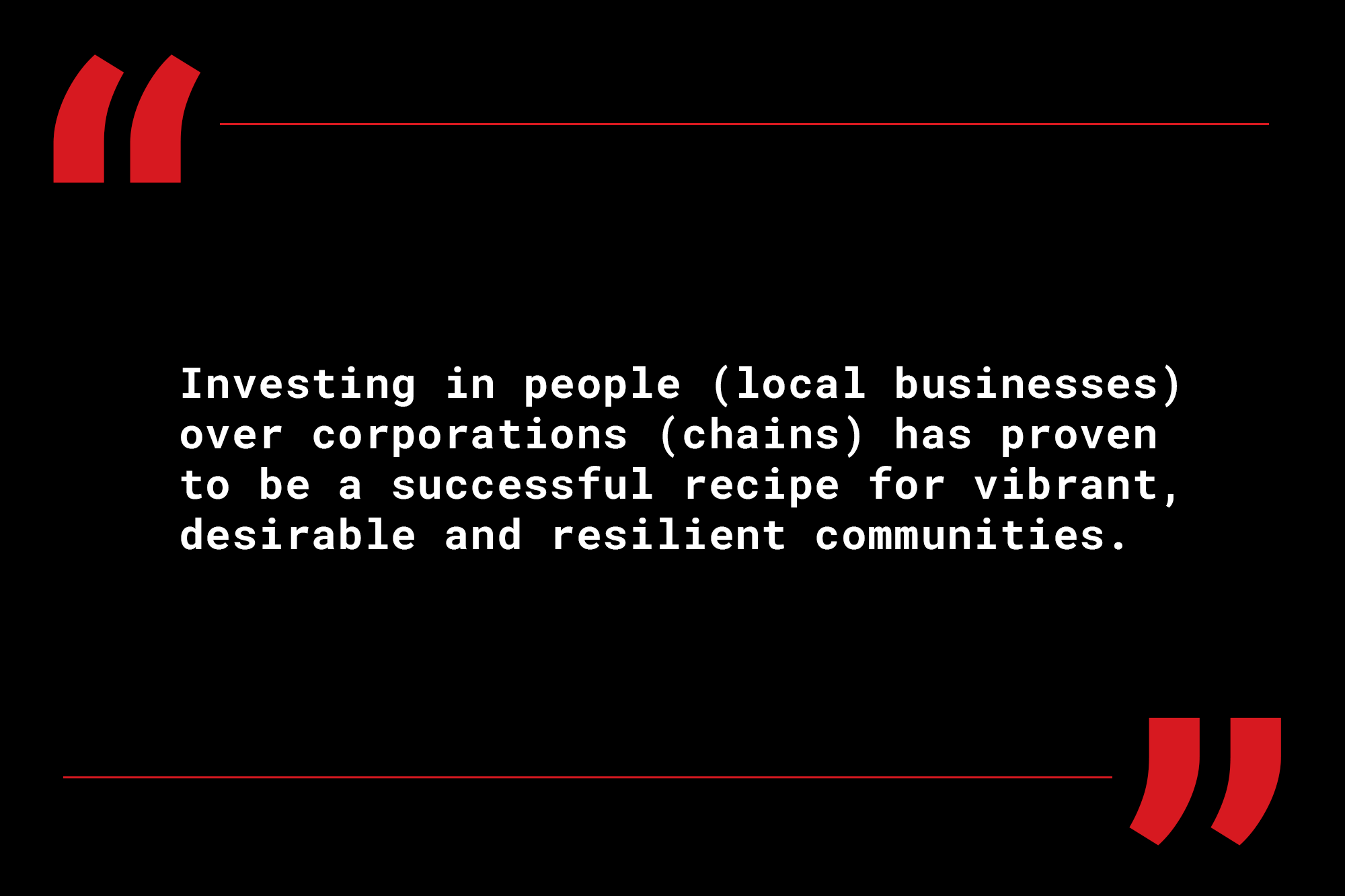The Retail Bright Spot
If nothing else, COVID has shown us just how important our local retail economy is. We’re stuck at home, our normal routines have shifted, including where our time and dollars are spent. The local grocer, wine shop, home & garden store, barbershop or salon, cheese monger, coffee shop, etc. have been fully integrated into your daily routines. They’ve pivoted, experimented and largely stayed open to serve us.
A recent New York Times article called Why SoHo Struggles and Indie Shops in Brooklyn Are Doing Fine (we’ve copied the text below), quotes a local home furnishings shop owner saying, “retail has to be integrated into people’s lives” referring to the relative success of a strip of shops along Atlantic Avenue in the Boerum Hill neighborhood in Brooklyn versus the prolific retail vacancy in the Soho Neighborhood of Manhattan.
Neighborhoods are most successful when grown organically, catering to the needs of a regular customer base. Investing in people (local businesses) over corporations (chains) has proven to be a successful recipe for vibrant, desirable and resilient communities. It’s very reasonable to assume that Graffito’s work going forward, as it has since inception, will continue with this very recipe in mind.
Why SoHo Struggles and Indie Shops in Brooklyn Are Doing Fine (Link)
Retail chains have failed all over New York City. Is it a surprise that smaller stores can finally breathe?
With the exception of November 1929, there has probably been no moment less conducive to opening a jewelry store in New York than at any point during the past 11 months. So it was a hopeful and norm-defying sign, like a heat wave in a Finnish noir, to find Page Sargisson Jewelry arriving on the corner of Hoyt Street and Atlantic Avenue in Brooklyn right after Thanksgiving.
Ms. Sargisson had been designing and making jewelry for 16 years, selling it wholesale and online. But she had long wanted to open a store, one that was big enough to accommodate a workshop. This past August, as the lease on her studio space was running out, she approached the owner of a building whose ground floor, like hundreds of other shop fronts around the city, had been empty for some time. She told him what she could pay. They came to an agreement. By the end of December, her sales had far exceeded her expectations.
When the pandemic struck late last winter, it devastated a retail sector that had been battered for at least a decade. Vacancy mounted upon vacancy, bankruptcy upon bankruptcy. By May, with hundreds of thousands of people living in pajamas, staffing at clothing stores was down by 40 percent from the previous year. Between February and October, nearly 30,000 retail jobs vanished in New York City alone. You hardly needed any kind of statistical analysis if you walked around Hudson Yards or SoHo or Madison Avenue, where everything has felt bleak, enervating: Karma was having its way with Big Real Estate.
By contrast, a chicly homey stretch of stores along well-traveled Atlantic Avenue in Brooklyn has maintained the vitality of an alternate world. These shops are an unlikely bright spot in a devastating year, when as many as one-third of all businesses in New York City have failed or been severely constrained. Any inquiry into how this has come to pass must begin with the fact that many of the stores belong to the individual people who created them.
The monuments to corporate branding — the Guccis and Pradas — that line so many of the desolate retail corridors in Manhattan are essentially absent here. In the 1980s and ’90s, this part of Atlantic Avenue was given over to modest antiques stores serving a new population of first-time homeowners restoring brownstones in Boerum Hill. As those houses turned over again and again in the years ahead, as linoleum was stripped away and the farmhouse sinks made their way into the kitchen, the surrounding area evolved to suit the tastes of a haute bohemian class that preferred its luxuries set at a lower register.
When you walk into one of these stores, you are likely to find the owner behind the counter. Often she — and it’s usually a woman — is also the person making what she sells: lamps, pillows, pottery, dresses, body oils. Michele Varian moved her interior design store from SoHo to Atlantic Avenue in January 2020 because the community she had first encountered when she opened 19 years earlier was long gone. “If I were in SoHo now, I’d be dead in the water, owing lots of money,” she told me recently. Her rent had become untenable at the same time that the sort of person who really appreciated what she carried no longer lived nearby.
Artists had left SoHo years earlier, but she noticed a second-wave exodus after Hurricane Sandy, when people traded in lofts they bought years earlier for whole buildings in Brooklyn. “I think this is an underrecognized, pivotal turning point in the history of Lower Manhattan,’’ Ms. Varian said.
The newcomers brought with them not only money, but the locavore values of liberal affluence. They were neither about Amazon nor Moncler. When a branch of Barneys opened on the ground floor of a new apartment building farther west on Atlantic Avenue, in Brooklyn Heights, it was empty nearly all the time, long before the company shut down. Even as people living in the area renovated vast townhouses — waiting two years for the arrival of $5,000 Japanese toilets, for example — they weren’t about to spend $2,800 on a slip dress.
But they were happy to shop in places that distinguished their tastes as artful. “Through all of this, the neighbors have been so aware of how important it is to support us,” Ms. Varian said.
The intimacy extends, crucially, to the landlords, who in several cases have held these properties for decades. The boutique owners have managed to avoid faceless real-estate investment trusts, huge development outfits or private equity interests who have seized upon neighborhoods based on Instagram ideas of hipness, with little understanding of what the people who live in them actually need or want.
These relationships have been important during the current crisis. “In March I called my landlord, freaking out,” Eva Dayton, a single parent, told me. Ms. Dayton, who owns Consignment Brooklyn, a vintage clothing store, has had the same landlord for 17 years. “He is like my dad,” she said. “His response when I called him was, ‘I am here to help you be successful.’” He forgave three months of rent.
Just before the pandemic, she had started a text group for the 12 like-minded women who own stores on the block. The network included Kalyn McCutcheon, who had just opened a midcentury modern furniture store; Marcia Patmos, a fashion designer; Gale Mayron, who was in the fortunate position to have been making a hand sanitizer with essential oils since 1997; and Yvonne Chu, who had been making wedding dresses in her store, Kimera, for two decades and who quickly began turning out masks. Nothing has been easy, but everyone has survived.
“We went through all of Covid together, texting each other every day about 500 things — P.P.P. loans, snow shoveling,” Ms. Dayton said. “We talk about everything. ‘You guys are having a sale? Maybe we’ll have a sale.’” At one point, before Christmas, they incentivized shopping in multiple stores by coordinating a traveling bingo game which culminated in prizes.
Chain stores have proliferated in New York City on the belief held by landlords and banks that they are more or less invulnerable to economic downturns. The pandemic has offered a profound challenge to that idea. In December, the Center for an Urban Future, a policy organization, issued its 13th annual study of national retailers in New York City. It found by far the biggest overall decline in the number of chain stores; more than 1,000 of them, or approximately one out of seven, had disappeared during the preceding 12 months.
The lessons would seem obvious — that neighborhoods do best when they evolve organically in sync with the people who live in them. They cannot be manufactured as if real life were Minecraft. In the micro sense there are hopeful signs — landlords tying rents to percent of sales, banks slowly becoming more flexible in their financing. But the way we think about commerce and communities needs a radical re-evaluation.
“Retail has to be integrated into people’s lives,” Ms. Varian remarked. “Where are people walking their dogs? Where are they taking their kids to school?” Those businesses then need to be supported. And in the end, the vultures need to be kept away.




